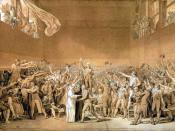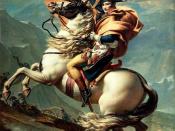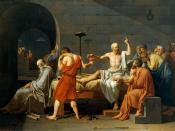The causes of the French Revolution are so complicated that a debate still rages among historians regarding its origins, causes and results. In general, the real causes must lie with the increasing discontent various members of society had for the rigid social structure of the Ancient Regime. As it had been for centuries, French society was divided into three Estates or Orders. The First Estate consisted of the clergy and the Second Estate the nobility. At the bottom of this hierarchy was the vast Third Estate, which meant every one else. The King ruled as absolute
monarch and there was no parliament. This social structure was based on inequalities which were sanctioned by the force of the law. There is no evidence to suggest that either Rousseau or David helped in causing the French Revolution. Certainly, Rousseau's philosophy did not advocate violence. However their political ideas, displayed through Rousseau's philosophy and David's paintings, questioned the established order and supported a democracy.
As celebrated figures, they helped to create what could be called a revolutionary mentality.
The essence of Rousseau's message was that society was corrupt but capable of regeneration. His Social contract, 1762, opens with the slogan, "Man is born free, and everywhere he is in chains."(Block 3, p96). The chains are the binds of society, but he was not talking about braking free from society, but rather considering how it can be right to live in society when the natural state is to be free. His conclusion; "we can be both free and ruled only if we rule ourselves." (Tutor's notes p2). This idea of
democracy would have been attractive to wealthy members of the Third Estate, who, although rich, were trapped in the system and could not get any of the power or privileges available to the Nobles.


